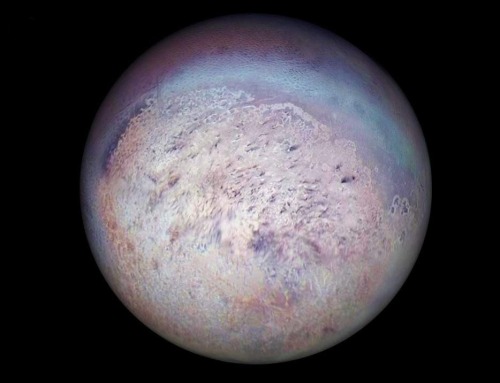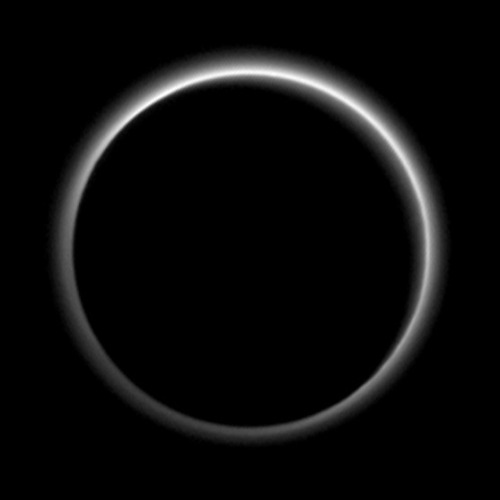111 posts
Latest Posts by scenesofspace - Page 3




The last shuttle

LA-LA LAND-ING The space shuttle Endeavour, perched atop a specially-modified NASA 747 jet, approaches Los Angeles International Airport last week. The retired spacecraft will be towed to its new home at the California Science Center. (Photo: Stephen Confer via NASA APOD)

Today NASA released parts of the set of highest-resolution pictures of Pluto from the New Horizons probe’s fly-by in July. As they write, “these latest images form a strip 50 miles (80 kilometers) wide on a world 3 billion miles away.” Imagine that. They are also the highest resolution images we’ll have of Pluto in a long, long time.
This picture, a crop, shows Sputnik Planum and the al-Idrisi mountains, which are made of big chunks of water ice. Be sure to check out the whole thing.




The Rings of Saturn and it’s moon, Enceladus.






Space cards


Triton, Neptune’s largest moon

Sunset On Pluto
via reddit
Cassini sippin' on Enceladus
Whoa, how have I not heard about this before today: the Cassini spacecraft is going to dive through a jet of water erupting from Enceladus, a Saturnian moon.
Discovering life was not on the agenda when Cassini was designed and launched two decades ago. Its instruments can’t capture microbes or detect life, but in a couple of dozen passes through the plumes of Enceladus, it has detected various molecules associated with life: water vapor, carbon dioxide, methane, molecular nitrogen, propane, acetylene, formaldehyde and traces of ammonia.
Wednesday’s dive will be the deepest Cassini will make through the plumes, only 30 miles above the icy surface. Scientists are especially interested in measuring the amount of hydrogen gas in the plume, which would tell them how much energy and heat are being generated by chemical reactions in hydrothermal vents at the bottom of the moon’s ocean.
That’s pretty crazy…it sounds like science fiction. NASA is doing a wonderful job producing great science with the lean budgets they are given.








Strange moons
The Sweden Solar System
Spanning from comets in the south to the termination shock zone in the northern part of the country, The Sweden Solar System is a scale model of the solar system that spans the entire country of Sweden, the largest such model in the world.
The Sun is represented by the Ericsson Globe in Stockholm, the largest hemispherical building in the world. The inner planets can also be found in Stockholm but the outer planets are situated northward in other cities along the Baltic Sea.

All the planets in the solar system would fit between the Earth and the Moon
A tour of the vastness of the Universe
From astrophysicist Robert Simpson, a tour of the Universe from humans to the largest structure of the Universe. The piece is full of interesting little bits like:
The average female is 1.62 metres [tall] – that’s 5.4 light-nanoseconds.
If the Earth was a beach ball then all life on Earth exists within just 1mm around the surface.
Out by Pluto, the Sun itself is has dimmed to look like an other stars.
If the Sun was a blood cell then the Milky Way is the size of Europe.
See also Steven Strogatz on the Sagan Planet Walk in Ithaca, NY.
As you stroll from one to another, you can’t help noticing that the first four planets are really close together. It takes a few seconds, a few tens of steps, to walk from the Sun to Mercury and then on to Venus, Earth and Mars. By contrast, Jupiter is a full two-minute walk down the block, just past Moosewood Restaurant, waiting for someone to stop by and admire it. The remaining planets are even lonelier, each marooned in its own part of town. The whole walk, from the Sun to Pluto, is about three-quarters of a mile long and takes about 15 minutes.
My favorite detail: they added a new station to the Sagan Walk, the star nearest to our solar system. It’s in Hawaii.
Space Probes
The Spaceprob.es site tracks the active probes in operation in and around our solar system, from Voyager I (19.56 billion km from Earth) to the Artemis probes (358,000 km away). (via @BadAstronomer)


Jennifer Daniel
Vote for Place of the Year 2015

Was 2015 the year of Pluto? Or does its exit from the Eurozone make Greece Place of the Year? Now is the time to vote and tell us which place made the most history this year.
In the meantime, reflect on 2014 Place of the Year, Scotland.
Image: Public Domain via Wikimedia Commons.
The most mysterious star in the Milky Way
Astronomers are interested in the goings-on around a star in our galaxy called KIC 8462852. There appears to be a lot of debris around it, which is a bit unusual and might have any number of causes, including that an extraterrestrial intelligence built all sorts of things around the star.
Jason Wright, an astronomer from Penn State University, is set to publish an alternative interpretation of the light pattern. SETI researchers have long suggested that we might be able to detect distant extraterrestrial civilizations, by looking for enormous technological artifacts orbiting other stars. Wright and his co-authors say the unusual star’s light pattern is consistent with a “swarm of megastructures,” perhaps stellar-light collectors, technology designed to catch energy from the star.
“When [Boyajian] showed me the data, I was fascinated by how crazy it looked,” Wright told me. “Aliens should always be the very last hypothesis you consider, but this looked like something you would expect an alien civilization to build.”
Boyajian is now working with Wright and Andrew Siemion, the Director of the SETI Research Center at the University of California, Berkeley. The three of them are writing up a proposal. They want to point a massive radio dish at the unusual star, to see if it emits radio waves at frequencies associated with technological activity.
Phil Plait has more context on this weirdo star and how the alien angle is pretty far-fetched but also worth checking out.
Where did the Moon come from?

The Moon is about 40 to 140 million years younger than the Earth and its geology offers broad hints that it was formed in an impact. This is called the giant impact hypothesis.
Nobody can be sure what actually happened, but computer simulations provide some clues. In one simulation, the newly-formed Earth suffers an impact with another planet (called Theia, a little larger than Mars). Theia is torn apart, its core dragged down through Earth’s interior to merge with the Earth’s core. Much of Theia’s mantle is absorbed into Earth’s mantle, and the side of Theia furthest away from the impact is hurled into space. About half the material ejected by the collision is lost and the rest accretes to form the Moon.
The Earth’s axis is tilted, and it is left spinning faster than it does today. A day lasts about ten hours. Months are much shorter too, as the new Moon orbits the Earth much faster. It is also much closer. Had there been anyone on Earth to observe it, they would have glimpsed a Moon twice the present size in the Earth’s primitive sky.
The Moon has since slowed the Earth’s spin, and it is moving away from us at a rate of almost 4 centimetres a year.
You can learn more about the birth of our Moon via Origins: The Scientific Story of Creation by Jim Baggott, or by following #BaggottOrigins across social media.
Image: Moon, by Yutaka Tsutano. CC-BY-2.0 via Flickr.

The northern pole of Pluto, in full high-resolution. Yes, that’s ice–methane ice.
Stunning.


Sirens of Titan

A view from Mars. Earth, Jupiter, and Venus

To scale, The Last Planet




For comparison purposes



The Dark Side of the Moon


In color and silhouette, The Last Planet






The Sirens of Titan